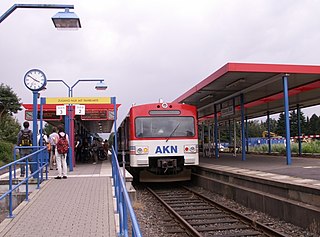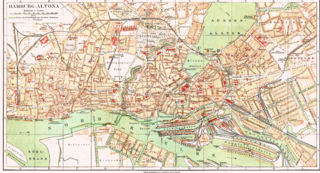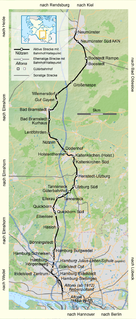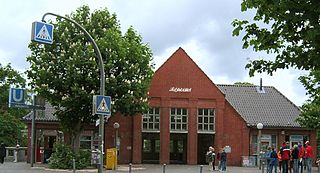
Hamburg Airport, known in German as Flughafen Hamburg, is a major international airport in Hamburg, the second-largest city in Germany. Since November 2016 the official name has become Hamburg Airport Helmut Schmidt, after the former German chancellor Helmut Schmidt. It is located 8.5 km (5.3 mi) north of the city centre in the Fuhlsbüttel quarter and serves as a hub for Eurowings and focus cities for Condor, Ryanair, and TUI fly Deutschland. It was formerly named Hamburg-Fuhlsbüttel Airport, a name still sometimes used.

The Hamburg S-Bahn is a suburban commuter railway network in the Hamburg Metropolitan Region. Together, the S-Bahn, the Hamburg U-Bahn, the AKN railway and the regional railway form the backbone of railway public transport in the city and the surrounding area. The network has operated since 1907 as a commuter rail system, under the direction of the state railway, and is a member of the Hamburger Verkehrsverbund. There are six lines, serving 68 stations, on 147 kilometres (91 mi) of route. On an average working day the S-Bahn transports about 590,000 passengers; in 2010 about 221 million people used the S-Bahn.

The Hamburg U-Bahn is a rapid transit system serving the cities of Hamburg, Norderstedt and Ahrensburg in Germany. Although technically an underground, most of the system's track length is above ground. The network is interconnected with the city's S-Bahn system, which also has underground sections. It is operated by Hamburger Hochbahn within the Hamburger Verkehrsverbund (HVV). It was opened in February 1912, and comprises four lines serving 93 stations, with a route length of 106.4 kilometres (66.1 mi) in 2019.

Hamburg Hauptbahnhof is the main railway station of the city of Hamburg, Germany. Opened in 1906 to replace 4 separate terminal stations, today Hamburg Hauptbahnhof is operated by DB Station&Service AG. With an average of 550,000 passengers a day, it is Germany's busiest railway station and the second-busiest in Europe after the Gare du Nord in Paris. It is classed by Deutsche Bahn as a category 1 railway station.

AKN Eisenbahn GmbH operates railway lines, commuter trains and freight trains in Hamburg and Schleswig-Holstein. Its headquarters is in Kaltenkirchen. It is a member of the Hamburger Verkehrsverbund (HVV), which organises public transport in and around Hamburg.

Langenfelde railway station is on the Altona–Kiel and the Altona–Neumünster lines and is served by the city trains and the commuter trains of the AKN railways plc. The station is named after the Langenfelde suburb. It is located in the Stellingen quarter in the Hamburg borough of Eimsbüttel, Germany. The station is managed by the DB Station&Service plc. for the public transport operator of Hamburg.

Stellingen is a railway station on the Hamburg-Altona–Kiel line, northern Germany, served by the Hamburg S-Bahn and the commuter trains of AKN (A-Bahn). The station is located in the Hamburg borough of Eimsbüttel, west of Hamburg Inner City, and a little east to Imtech Arena (Volksparkstadion). In direct neighborhood to the station, motorway A7 crosses above the elevated railway tracks.

Hamburg Airport (Flughafen) is a station on line S1 of the Hamburg S-Bahn, serving Hamburg's airport in the quarter of Fuhlsbüttel in the northeast of the city. It opened in 2008. According to S-Bahn Hamburg GmbH — owner and operator of the S-Bahn — about 13,500 passengers used the service per day in 2009, with an increase to 20,000 daily passengers by 2013. The station's name is identical in both English and German with the English word "airport" being used primarily in both languages and with the German equivalent "Flughafen" added in brackets.
Transport in Hamburg comprises an extensive, rail system, subway system, airports and maritime services for the more than 1.8 million inhabitants of the city of Hamburg and 5.3 million people in the Hamburg Metropolitan Region.

Ohlsdorf is a railway station in Hamburg, Germany, located at the junction of the Hamburg-Altona link line with the Alster Valley line and the Hamburg Airport line in Ohlsdorf, Hamburg near the Ohlsdorf Cemetery.

The Hamburg-Altona link line is a railway line in Hamburg, Germany. It now connects the lines from the north and west of Hamburg and Altona station with Hamburg Hauptbahnhof and the lines to the south and east. It was initially designed as a freight line only but is it now one of the busiest lines in Germany. It includes the suburban tracks of the Hamburg Stadtbahn, originally the core of the Hamburg S-Bahn.
The Alster Northern Railway or ANB was a non-electrified, single-tracked branch line in northern Germany. It linked the stations of Ochsenzoll in Hamburg-Langenhorn with Ulzburg Süd in the district of Segeberg in Schleswig-Holstein.

The Hamburg freight rail bypass is a railway line in the German city of Hamburg. It runs from Hamburg-Eidelstedt via Hamburg-Rothenburgsort to Hamburg-Harburg and connects the long-distance railways approaching Hamburg, bypassing the link line and the railway junctions on the approaches to Hamburg-Altona station and Hamburg Hauptbahnhof. The line is mainly used for rail freight.

The Hamburg-Altona–Neumünster railway is the original line of the AKN Eisenbahn (railway) in the German states of Hamburg and Schleswig-Holstein. Today, passenger services on the 64.5 km-long Hamburg Eidelstedt–Neumünster section are operated by AKN.

Ulzburg Süd station is a hub on the AKN Eisenbahn network in the municipality of Henstedt-Ulzburg in the German state of Schleswig-Holstein. It is where AKN’s trunk line and the Alster Northern Railway, which are now traversed by AKN lines A1 and A2, meet. In addition, trains on line A3 begin and end in Ulzburg Süd.

Kaltenkirchen is a rapid transit station on the Hamburg-Altona–Neumünster railway line, located some 30 kilometres (19 mi) north of Hamburg, in the center of Kaltenkirchen, a town in the German state of Schleswig-Holstein.

Fuhlsbüttel is a station on the Hamburg U-Bahn line U1. It was opened in July 1921 and is located in Hamburg, Germany, in the quarter of Fuhlsbüttel. Fuhlsbüttel is part of the borough of Hamburg-Nord.

Fuhlsbüttel Nord is a station on the Hamburg U-Bahn line U1. It was opened in July 1921 and is located in Hamburg, Germany, on the boundaries of the quarters of Fuhlsbüttel and Langenhorn. Both are part of the borough of Hamburg-Nord.

Ochsenzoll is a station on the Hamburg U-Bahn line U1. Until 1969, it was the north western terminus of the line. It was opened in July 1921 and is located in Hamburg, Germany, in the quarter of Langenhorn. Langenhorn is part of the borough of Hamburg-Nord.

The Bundesstraße 433 is a Bundesstraße in Hamburg.



















